
(a)
Interpretation:
The synthesis of
Concept introduction:
Oxymercuration reaction is a type of reaction in which an
Answer to Problem 11.61AP
The synthesis of

Explanation of Solution
The mercuric acetate

Figure 1
The route of synthesis of the formation of
(b)
Interpretation:
The synthesis of
Concept introduction:
The substances which on addition removes oxygen atom or hydrogen atom from the other substance, that is, reduces the other substances are known as reducing agents. Reducing agents themselves get oxidized. Strong reducing agents like
Answer to Problem 11.61AP
The synthesis of
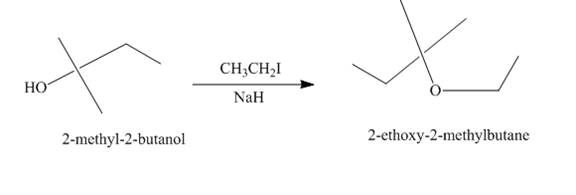
Explanation of Solution
The treatment of
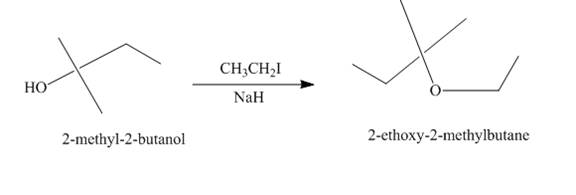
Figure 2
The route of synthesis of the formation of
(c)
Interpretation:
The synthesis of
Concept introduction:
Grignard reagents are
Answer to Problem 11.61AP
The synthesis of

Explanation of Solution
The reaction of tert-butyl bromide with

Figure 3
The route of synthesis of the formation of
(d)
Interpretation:
The synthesis of the given compound from the compounds that contain
Concept introduction:
Oxidation is the process in which there is an addition of oxygen atom or removal of hydrogen atom. The agents used for the oxidation reaction is known as oxidizing agents. It oxidizes the other substance and gets reduced in the reaction. The common oxidizing agents are nitric acid, oxygen and potassium dichromate.
Answer to Problem 11.61AP
The synthesis of the given compound from the compounds that contain

Explanation of Solution
The reaction of ethnethiol with
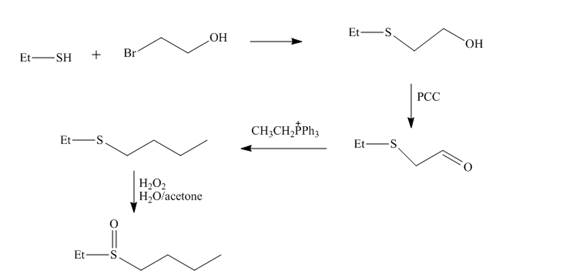
Figure 4
The synthesis of the given compound from the compounds that contain
(e)
Interpretation:
The synthesis of the given compound from an alkene is to be drawn.
Concept introduction:
Oxidation is the process in which there is an addition of oxygen atom or removal of hydrogen atom. The agents used for the oxidation reaction is known as oxidizing agents. It oxidizes the other substance and gets reduced in the reaction. The common oxidizing agents are nitric acid, oxygen and potassium dichromate.
Answer to Problem 11.61AP
The synthesis of the given compound from an alkene is shown below.
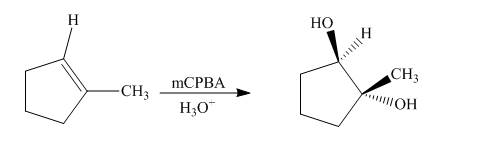
Explanation of Solution
The reaction of

Figure 5
The synthesis of the given compound from an alkene is shown in Figure 5.
(f)
Interpretation:
The synthesis of cyclohexyl isopropyl ether from cyclohexene is to be drawn.
Concept introduction:
Oxidation is the process in which there is an addition of oxygen atom or removal of hydrogen atom. The agents used for the oxidation reaction is known as oxidizing agents. It oxidizes the other substance and gets reduced in the reaction. The common oxidizing agents are nitric acid, oxygen and potassium dichromate.
Answer to Problem 11.61AP
The synthesis of cyclohexyl isopropyl ether from cyclohexene is shown below.
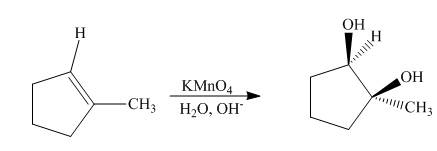
Explanation of Solution
The compound,

Figure 6
The synthesis of cyclohexyl isopropyl ether from cyclohexene is shown Figure 6.
(g)
Interpretation:
The synthesis of cyclohexyl isopropyl ether from cyclohexene is to be drawn.
Concept introduction:
Oxymercuration reaction is a type of reaction in which an alkene gets converted to alcohol. The mercuric acetate is used in the reaction as a reagent. This reagent attacks the alkene to form a cyclic intermediate compound which further undergoes reduction to form alcohol.
Answer to Problem 11.61AP
The synthesis of cyclohexyl isopropyl ether from cyclohexene is shown below.

Explanation of Solution
The mercuric acetate

Figure 7
The synthesis route of cyclohexyl isopropyl ether from cyclohexene is shown in Figure 7.
(h)
Interpretation:
The synthesis of the given compound from
Concept introduction:
Grignard reagents are organometallic compounds which are prepared using alkyl halides in the presence of magnesium metal in dry ether. These reagents act as strong nucleophiles and bases
Answer to Problem 11.61AP
The synthesis of the given compound from
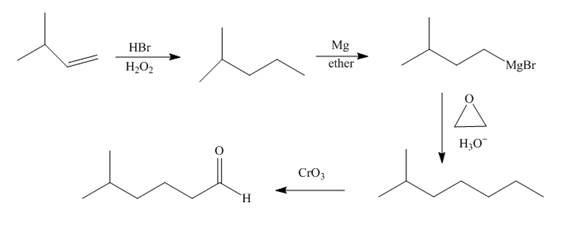
Explanation of Solution
Bromination of alkene occurs with
Grigmard reagent reacts with the ethylene oxide followed by the hydrolysis to form an alcohol which upon oxidation by
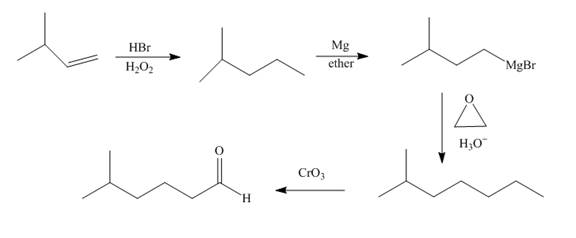
Figure 8
The synthesis of the given compound from
(i)
Interpretation:
The synthesis of the given compound from
Concept introduction:
An
Oxidation is the process in which there is an addition of oxygen atom or removal of hydrogen atom. The agents used for the oxidation reaction is known as oxidizing agents. It oxidizes the other substance and gets reduced in the reaction. The common oxidizing agents are nitric acid, oxygen and potassium dichromate.
Answer to Problem 11.61AP
The synthesis of the given compound from
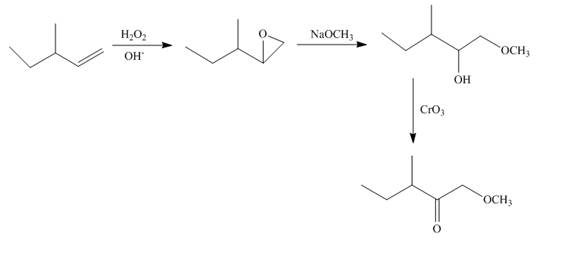
Explanation of Solution
Epoxidation of

Figure 9
The synthesis route of the given compound from
(j)
Interpretation:
The synthesis of the given compound from
Concept introduction:
An epoxide is cyclic ether. It can be prepare by the reaction of alkene with percarboxylic acid with removal of carboxylic acid. An epoxide undergoes ring opening reactions with an acid to give a product with inversion configuration.
Oxidation is the process in which there is an addition of oxygen atom or removal of hydrogen atom. The agents used for the oxidation reaction is known as oxidizing agents. It oxidizes the other substance and get reduced in the reaction. The common oxidizing agents are nitric acid, oxygen and potassium dichromate.
Answer to Problem 11.61AP
The synthesis of the given compound from

Explanation of Solution
Epoxidation of

Figure 10
The synthesis route of the given compound from
(k)
Interpretation:
The synthesis of given compound from the allyl chloride is to be drawn.
Concept introduction:
The nucleophilic substitution reactions depend upon the nucleophilicity and concentration of the nucleophile. There are two types of nucleophilic substitution reaction.
The
Answer to Problem 11.61AP
The synthesis of given compound from the allyl chloride is shown below.

Explanation of Solution
Allyl chloride reacts with

Figure 11
The synthesis of given compound from the allyl chloride is shown in Figure 11.
(l)
Interpretation:
The synthesis of the given compound is to be drawn.
Concept introduction:
Wolff Kishner Reduction is a reaction in which aldehydes and
Answer to Problem 11.61AP
The synthesis of the given compound is shown below.
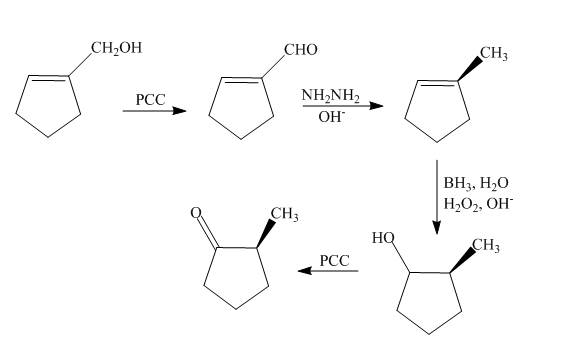
Explanation of Solution
The reaction of cyclopentenyl methanol with

Figure 12
The synthesis of the given compound is shown in Figure 12.
(m)
Interpretation:
The synthesis of the given compound is to be drawn.
Concept introduction:
The substances which on addition removes oxygen atom or hydrogen atom from the other substance, that is, reduces the other substances are known as reducing agents. Reducing agents themselves get oxidized. Strong reducing agents like
Answer to Problem 11.61AP
The synthesis of the given compound is shown below.

Explanation of Solution
The alcohol is reduced in presence of

Figure 13
The synthesis of the given compound is shown in Figure 13.
Want to see more full solutions like this?
Chapter 11 Solutions
Organic Chemistry Study Guide and Solutions
- Answe Answer A and B pleasearrow_forward3. Refer to the data below to answer the following questions: Isoelectric point Amino Acid Arginine 10.76 Glutamic Acid 3.22 Tryptophan 5.89 A. Define isoelectric point. B. The most basic amino acid is C. The most acidic amino acid is sidizo zoarrow_forward3. A gas mixture contains 50 mol% H2 and 50 mol% He. 1.00-L samples of this gas mixture are mixed with variable volumes of O2 (at 0 °C and 1 atm). A spark is introduced to allow the mixture to undergo complete combustion. The final volume is measured at 0 °C and 1 atm. Which graph best depicts the final volume as a function of the volume of added O2? (A) 2.00 1.75 Final Volume, L 1.50 1.25 1.00 0.75 0.50 0.25 0.00 0.00 0.25 0.50 2.00 (B) 1.75 1.50 Final Volume, L 1.25 1.00 0.75 0.50- 0.25 0.00 0.75 1.00 0.00 0.25 Volume O₂ added, L 2 0.50 0.75 1.00 Volume O₂ added, L 2 2.00 2.00 (C) (D) 1.75 1.75 1.50 1.50 Final Volume, L 1.25 1.00 0.75 0.50 Final Volume, L 1.25 1.00 0.75 0.50 0.25 0.25 0.00 0.00 0.00 0.25 0.50 0.75 1.00 0.00 0.25 Volume O₂ added, L 0.50 0.75 1.00 Volume O₂ added, L 2arrow_forward
- Leucine is an essential amino acid with the systematic name 2-amino-3-methylpentanoic acid. It has pai 2.36 and pKa2 = 9.60. H2N-C(R)H-COOH and R is -CH2-CH(CH3)2 A. Draw the condensed structure for leucine, and label all chirality centers with an asterisk. B. How many possible stereoisomers of leucine are there? C. Draw a Fischer projection of L-leucine and label the chirality center(s) as R or S. D. What is the p/ of leucine? E. Draw the structure of the predominant form of leucine at 10.00. F. Draw the structure of the predominant form of leucine at pH = 1.50. G. Leucine is described as an essential amino acid. What does this mean? H. Show the alkyl halide you would use to prepare leucine by the amidomalonate method. =arrow_forwarda) Write out 6 completely different reactions of acetophenone (reagent, product). b) Write out 3 preparations of 1-methylcyclohexanol, using a different starting material for each one. You may use preps where you just change the functional group, and/or preps where you construct the carbon chain. c) Write out 3 preparations of 2-ethoxybenzoic acid, a different starting material for each one. You may use preps where you just change the functional group, and/or preps where you construct the carbon chain.arrow_forward12. CH3 OH OH H&C CH3 H₂C N OH H₂C CH3 H&C CH3 H₂C' CH3 H.C CH3OH H.C CH2CH3OH CH3CEN Which one of these 17 compounds is represented by this IR and this 'H NMR spectrum? IR Spectrum 3000 4000 3000 NMR Spectrum 2000 £500 RAVENUMBER 2000 1500 9 8 6 5 10 HP-00-290 ppm m 1000 500 1000 4 °arrow_forward
- Draw the structure of (E,6R) 6-methoxy-4-hepten-2-one. Give the IUPAC name of this compound, including stereochemistry. Draw the most stable chair conformation of (cis) 1,3-isobutylcyclohexane. H HC=CCH₂ CH2CH3 EN(CH3)2 -CN(CH3)2arrow_forward10. Write out the mechanism (intermediate/transition state) for this reaction; indicate stereochemistry in product. H3C CH₂OH CH3 SN1 Harrow_forwardWrite "most" under the member of each trio which is most stable. Write "least under the member of each trio which is least stable. b) Draw a Fischer projection of a pair of enantiomers with three chiral carbons. Which of these two would you expect to be more soluble in water? Why? 1-butanol 1-heptanol Which of these two would you expect to have the higher boiling point? Why? hexyl methyl ether 1-heptanolarrow_forward
- Write "most" under the most acidic compound. Write "least" under the least acidic compound. OH NO₂ OCH3 Br 9. Compound X, C50H84F2, reacts with excess H2/Pd to give a C50H88F2 compound. How many rings are in X? How many double bonds are in X? Show your work.arrow_forward4. State whether these two are: a) the same molecule b) c) d) different compounds that are not isomers constitutional isomers diastereomers e) enantiomers CH3 CH₁₂ H OH HO H H OH HO H CH, CH₂ 5. a) How many stereocenters does this compound have? b) How many stereoisomers are possible for this compound? CH₂ OH CHCHarrow_forwardCalculating the pH at equivalence of a titration A chemist titrates 210.0 mL of a 0.1003 M hydrobromic acid (HBr) solution with 0.7550M KOH solution at 25 °C. Calculate the pH at equivalence. Round your answer to 2 decimal places. Note for advanced students: you may assume the total volume of the solution equals the initial volume plus the volume of KOH solution added. pH = ] ☑ o0o 18 Ararrow_forward
 ChemistryChemistryISBN:9781305957404Author:Steven S. Zumdahl, Susan A. Zumdahl, Donald J. DeCostePublisher:Cengage Learning
ChemistryChemistryISBN:9781305957404Author:Steven S. Zumdahl, Susan A. Zumdahl, Donald J. DeCostePublisher:Cengage Learning ChemistryChemistryISBN:9781259911156Author:Raymond Chang Dr., Jason Overby ProfessorPublisher:McGraw-Hill Education
ChemistryChemistryISBN:9781259911156Author:Raymond Chang Dr., Jason Overby ProfessorPublisher:McGraw-Hill Education Principles of Instrumental AnalysisChemistryISBN:9781305577213Author:Douglas A. Skoog, F. James Holler, Stanley R. CrouchPublisher:Cengage Learning
Principles of Instrumental AnalysisChemistryISBN:9781305577213Author:Douglas A. Skoog, F. James Holler, Stanley R. CrouchPublisher:Cengage Learning Organic ChemistryChemistryISBN:9780078021558Author:Janice Gorzynski Smith Dr.Publisher:McGraw-Hill Education
Organic ChemistryChemistryISBN:9780078021558Author:Janice Gorzynski Smith Dr.Publisher:McGraw-Hill Education Chemistry: Principles and ReactionsChemistryISBN:9781305079373Author:William L. Masterton, Cecile N. HurleyPublisher:Cengage Learning
Chemistry: Principles and ReactionsChemistryISBN:9781305079373Author:William L. Masterton, Cecile N. HurleyPublisher:Cengage Learning Elementary Principles of Chemical Processes, Bind...ChemistryISBN:9781118431221Author:Richard M. Felder, Ronald W. Rousseau, Lisa G. BullardPublisher:WILEY
Elementary Principles of Chemical Processes, Bind...ChemistryISBN:9781118431221Author:Richard M. Felder, Ronald W. Rousseau, Lisa G. BullardPublisher:WILEY





